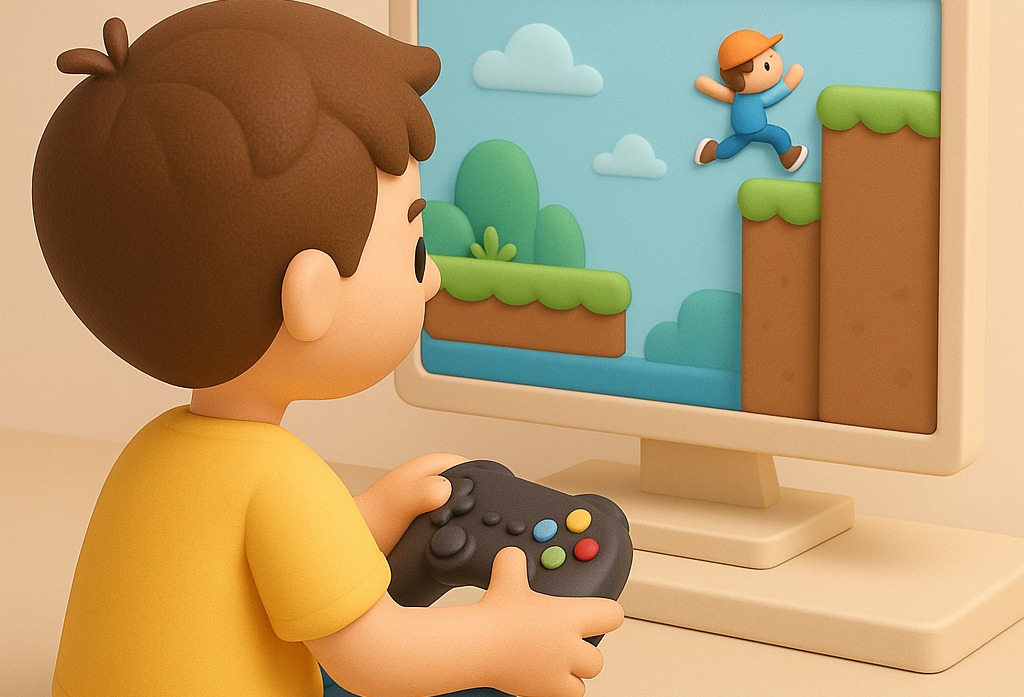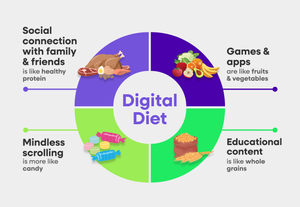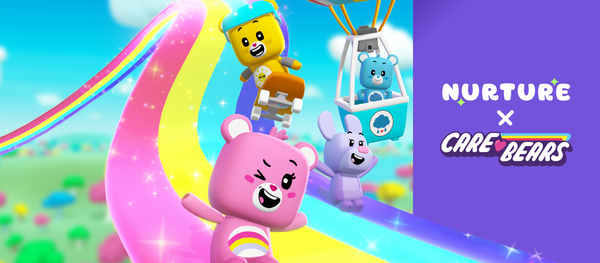Parents often carry guilt about screen time, particularly when it is used as a temporary distraction tool. But as digital parents, screens are not just a single-use tool, or a “special occasion” treat, or a “threat” to the global health and well-being of our children. If you want to be thoughtful and intentional about how your kids use screens, I encourage you to consider the difference in games versus shows (or TV, movies, YouTube, etc.).
Digital gaming is a great way to help kids nurture a growth mindset and develop resilience. Games are rooted in what psychologists often refer to as “a growth mindset,” which is the belief that abilities are developed through effort, learning, and persistence. As such, games also provide an environment to develop resilience, which is the ability to bounce back from setbacks, adapt to challenges, and recover from difficult experiences.
Fail from jumping up a high wall? Try it again! Did you not beat your little brother on Rainbow Road? Try a different car (or lay a more strategic banana peel). By design, games offer nearly endless opportunities to build the foundations of resilience and achieve a growth mindset, making them uniquely beneficial for modeling and practicing these skills.
See, I told you screens are far more than just a simple distraction.
What Does Resilience and Growth Mindset Mean in Early Childhood?
When we talk about resilience in young kids, we’re really talking about the ability to bounce back from setbacks, try again after frustration, and keep going even when something feels hard. It’s not about being tough or never feeling upset. It’s about knowing that when things go wrong, we can learn, grow, and move forward. It’s about working through tough emotions and using them as signals, not obstacles or endpoints.
This is where a growth mindset comes in. A growth mindset is the belief that you can improve through effort, strategy, and learning. It’s confidence that failure isn’t proof of incompetence, but a challenge to grow from.

Resilience is how you enact a growth mindset. Neither of these skills are something kids are born with. These are not traits they typically learn at school. That’s why it’s called a mindset. Kids absorb these beliefs through encouragement, modeled behavior, and the kinds of experiences we give them.
There is a range of skills that help build resilience in early childhood:
- Growth mindset: Believing “I can’t do it… yet” instead of “I can’t do it at all”
- Emotional regulation: Learning how to recognize, name, and manage big feelings like frustration or disappointment
- Problem-solving and critical thinking: Figuring out new approaches when the first try doesn’t work
- Self-efficacy: The growing belief that I can try hard things and make progress
As described by the Harvard Center on the Developing Child, resilience develops through the presence of supportive adult relationships, opportunities to build adaptive skills, and repeated chances to practice coping strategies in the face of manageable stress.
Younger kids, ages 4 to 7, are a prime window for learning all of this. At this stage, kids are innately driven to take initiative, which means they’re naturally curious, eager to try things, and excited to show what they can do.
When we, or the digital games they play, scaffold those efforts, it helps them understand their feelings, break problems into steps, and reflect on what they’ve learned. It is laying the groundwork for resilient, confident learners.
Resilience isn’t about never falling off the bike. It’s about knowing they can get back on. Kids need to learn to believe that each attempt is a step toward success.
Why Digital Play Can Support Resilience
Once you get past the myth that all screen time is the same, or all screen time is just passive enjoyment, it’s easy to see where resilience and growth mindset development show up.
While shows and videos can be entertaining and even model emotional experiences, they’re not interactive. They don’t ask kids to make choices, solve problems, or try again when something goes wrong.
Digital games, on the other hand, do all of that. The International Journal of Game-Based Learning ran an experiment specifically on using digital games to foster a growth mindset and found the game to make a world of difference. They can also bolster these learnings by developing autonomy, creativity, and a sense of self.
Even bio-responsive platforms like Mightier, a video game system developed through Boston Children’s Hospital and Harvard Medical School, demonstrate how gameplay can directly build emotional resilience by requiring kids to regulate stress while they play.
Games model persistence and problem-solving by design, two cornerstones of resilience building. All games require you to get better over time in order to succeed. Essentially, they offer safe failure: a way for kids to try, fail, regroup, and try again, without bigger consequences.
Critically, in games, we’re doing it, not just watching someone else do it. It is literally the core mechanics of how games themselves are built. For example, consider some of these core game mechanics:
- Retry mechanics build persistence. Most games are built around second chances. If you fail a level, you try again. Perhaps you fail again, but you make a little progress each time. That kind of scaffolding naturally supports a growth mindset.
- Creative problem-solving is also baked in. Whether it’s solving a puzzle, figuring out a new path, or building something from limited tools, games give kids structured opportunities to think flexibly.
- Emotional regulation gets practice, too. When kids lose a game or face an in-game setback, they feel it. But the stakes are low, and that makes it a great space to practice managing frustration or regrouping after disappointment.
We can look to examples in Nurture where these elements show up constantly. In certain levels, kids must approach challenges and build things with limited resources. They have to think about scarcity, resourcefulness, perseverance, and trial and error. The layer of fun and engagement keeps them encouraged to keep trying.
Nurture is also based on role-playing scenarios where kids take on a new perspective, then face setbacks through the eyes of that character. They might have to help a character make a tough decision, overcome a failure, or try a new approach. These moments spark reflection and show that setbacks are part of the process, not the end of the story.
Exercising resilience might actually be the greatest thing that games can offer us. It's not just entertainment — although they are very entertaining, too — but active practice in how to try, learn, and try again. That’s the heart of resilience. That builds a growth mindset in kids.
Resilience Activities: Nurture a Growth Mindset Through Digital Play
It doesn’t take a complicated curriculum to build a growth mindset by practicing resilience using digital play. Video games are built for this by nature. It’s what makes them fun. They give kids a chance to bounce back, be curious, and keep trying. With a little intention, we can fine-tune their screen time experiences to emphasize a growth mindset.
Here are a few ways to go about it.
Encouraging Positive Self-Talk & Mindset
Digital games can support positive self-talk when characters model perseverance, affirm effort, or reflect on mistakes with language like, “That was tricky, but I figured it out.” Even simple actions, such as retrying a level or earning a reward after multiple failed attempts, reinforce the idea that progress comes from persistence, not perfection.

Knowing this, Nurture has integrated affirmations and encouragement into gameplay and character dialogue.
Caregivers can help this land by talking aloud during co-play:
- “Oops, I missed that — but now I know what to try next.”
- “It feels good to get better each time I retry this level.”
- I’m proud of myself for working through my frustration!”
This kind of language helps kids internalize growth-oriented self-talk. Creative apps also let kids build digital collages or characters to express positive traits like bravery or kindness, which reinforces a strong internal voice over time.
Practicing Problem-Solving & Adaptability
Digital games regularly challenge kids to think flexibly and adjust when things don’t go as expected. Whether they’re solving a puzzle, navigating an obstacle course, or making story-based choices, these moments require creative thinking, trial and error, and a willingness to try again with a new approach.
Games like Minecraft, or others in which you design environments or levels, can take this even further. Parents can help by co-designing levels with intentional obstacles, then asking questions like:
- “What else could we try?”
- “How could we solve this a different way?”
- “Should we change our plan?”
This kind of support helps kids see setbacks not as roadblocks, but as invitations to problem-solve and adapt.
Developing Emotional Regulation & Coping
- Examples: Mindfulness apps (like Moshi), rhythm or music games that help with emotional pacing, storytelling games that name and navigate big feelings.
- Activity idea: Use an avatar builder to create characters representing emotions or “resilience heroes.”
- Caregiver tip: Pause and reflect — help your child name how they’re feeling when stuck or frustrated
Mistakes in games can trigger real frustration, but that’s actually a good thing. When kids lose a level, miss a move, or get stuck, they experience emotional responses in a safe, low-stakes environment. These moments offer powerful opportunities to help kids pause, recognize what they’re feeling, and regroup.
You can support this by prompting reflection during or after play:
- “That looked frustrating. Want to take a quick breath before trying again?”
- “How did you feel when that didn’t work?”
- “What helped you calm down and keep going?”
Over time, kids begin to recognize their emotions and develop strategies to regulate them. That’s an essential foundation for resilience.
Fostering Connection & Support
Collaborative games teach kids that resilience isn’t just a solo skill, it’s often something we build together. Working with a teammate, which could be a game character or a co-player, toward a shared goal encourages communication, turn-taking, and mutual encouragement, especially when something doesn’t go to plan.
After a co-op or collaborative session, You can guide reflection with questions like:
- “What helped you two work together?”
- “What did you do when your teammate got stuck?”
- “How did it feel to get through that challenge together?”
These moments show kids that supporting others (and being supported) is a big part of bouncing back from difficulty.
Promoting a Growth Mindset Through Games
The structure of most games encourages a growth mindset: try, fail, learn, and try again. Instead of punishing mistakes, games often reward persistence, experimentation, and strategy. These are all the ingredients kids need to see progress as something they earn, not something they are.
We can reinforce this by reframing failures in the moment:
- “You didn’t beat it yet — but you’re figuring it out.”
- “You’re getting better each time you try.”
- “I noticed how you changed your strategy — that’s smart thinking.”
When we celebrate effort and learning instead of just outcomes, we help kids internalize the idea that abilities grow with practice.
Supporting Resilience Through Digital Play: Bounce Forward, Not Back
Building resilience doesn’t happen in one big moment. It happens in small, everyday experiences. When it comes to screen time, parents and caregivers play a powerful role in shaping those experiences into something that can support resilience.
Think about screen time in terms of the Three C’s:
- Content: What is your child playing?
- Context: When and why are they playing?
- Connection: Who are they interacting with?
Parents can support resilience by staying close during gameplay. Narrate your own mistakes and learning moments out loud. Validate your child’s feelings when something is hard, and celebrate the effort they put in, not just the result. Be curious instead of corrective.
Mindset takes time. Nobody becomes a problem-solver, a creative thinker, or a calm-in-the-face-of-failure kind of kid overnight. But when we treat screen time as an opportunity for reflection, persistence, and emotional growth, we’re helping kids build the inner strength to try, learn, and try again — and that’s what resilience is all about.
Dig into the full Parent's Guide to Screen Time for Kids to learn more about applying the Three C’s and other intentional choices in your family’s digital wellness plan.






 Copy Link
Copy Link
 Share
to X
Share
to X
 Share
to Facebook
Share
to Facebook
 Share
to LinkedIn
Share
to LinkedIn
 Share
on Email
Share
on Email




